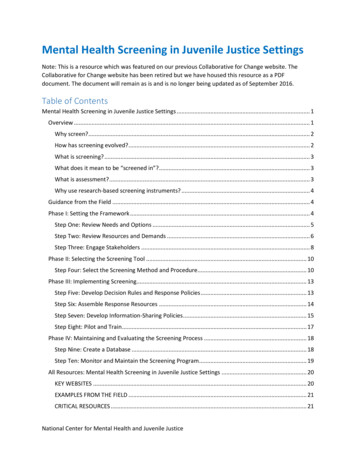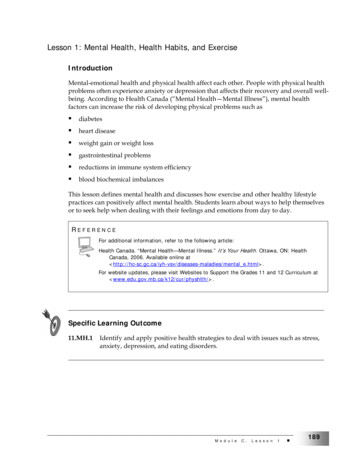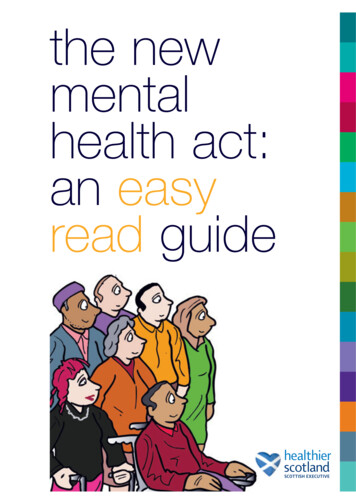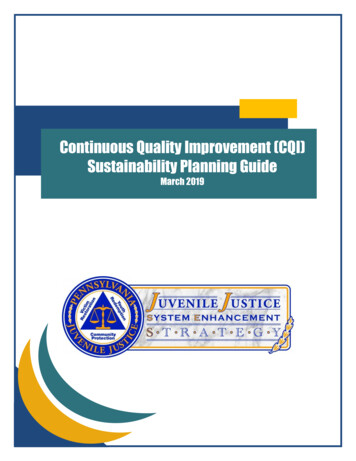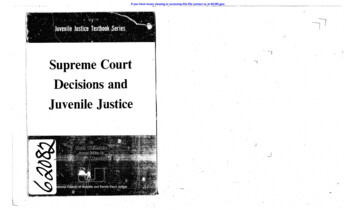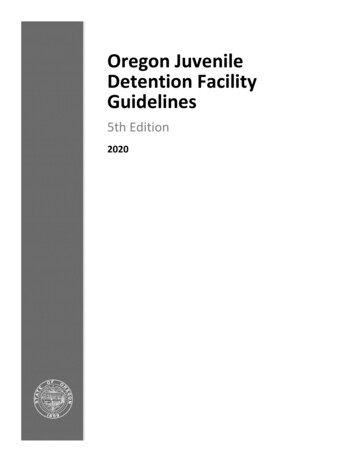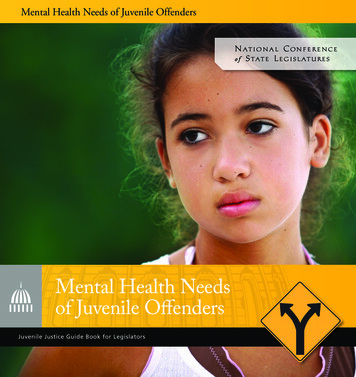
Transcription
Mental Health Needs of Juvenile OffendersMental Health Needsof Juvenile OffendersJuvenile Justice Guide Book for Legislators
Mental Health Needs of Juvenile OffendersIntroductionChildren with mental health needs sometimes enter a juvenilejustice system ill-equipped to assist them. Between 65 percentand 70 percent of the 2 million children and adolescentsarrested each year in the United States have a mental healthdisorder. Approximately one in four suffers from a mental illnessso severe it impairs his or her ability to function as a youngperson and grow into a responsible adult.Without treatment, the child may continue on apath of delinquency and eventually adult crime.Effective assessments of and comprehensive responsesto court-involved juveniles with mental health needscan help break this cycle and produce healthier youngpeople who are less likely to act out and commitcrimes. The importance of screening and treatmentare also discussed in the Delinquency Prevention &Intervention chapter of this guidebook.265-70%Between 65 percent and 70 percent of the2 million children and adolescents arrestedeach year in the United States have amental health disorder.
Juvenile Justice Guide Book for LegislatorsDisorders Prevalent Among Youth in the General PopulationAmerican children and teenagers sometimesof approximately 5.4 million American childrenexperience conduct, mood, anxiety and substancesuffer from ADHD, and 4.8 percent of them takeabuse disorders. Often, they have more than onemedication for their condition.disorder; the most common “co-occurrence” issubstance abuse with a mental illness. Frequently,these disorders put children at risk for troublesomebehavior and delinquent acts.Emotional disorders occur when a child’s ability tofunction is impaired by anxiety or depression. TheCenter for Mental Health Services estimates that 1 inevery 33 children and 1 in 8 adolescents are affectedBehavioral disorders are characterized by actionsby depression, a potentially serious mood disorder thatthat disturb or harm others and that cause distress oralso afflicts many adults. The occurrence of depressiondisability. Attention Deficit Hyperactivity Disorderamong juvenile offenders is significantly higher than(ADHD) and conduct disorders are typical youthamong other young people.behavioral disorders. According to the Center forDisease Control, an estimated 9 percent to 10 percent3
Mental Health Needs of Juvenile OffendersYouth in the Juvenile Justice SystemMany juveniles who commit delinquent acts havea history of substance abuse. In the Department ofJustice’s Arrestees Drug Abuse Monitoring Program,half the male juveniles arrested in nine separate sitestested positive for at least one drug. Studies also haveScreening and assessment are vital to addressingmental health treatment needs of youths in thejuvenile justice system.shown that up to two-thirds of juveniles in the justicesystem with any mental health diagnosis had dualdisorders, most often including substance abuse.Screening and assessment areIn 2006, the National Mental Health Associationreported that the prevalence of disruptive behaviordisorders among youth in juvenile justice systems isbetween 30 percent and 50 percent.juvenile justice system.Anxiety disorders, post-traumatic stress disorderin particular, also are prevalent among juvenileoffenders, especially girls. Psychotic disorders suchas schizophrenia, however, are rare in the generalpopulation as well as in children involved in thejustice system.Mental Health Assessmentand TreatmentMental health disorders are more complicated anddifficult to treat in young people than in adults.Because adolescence is a unique developmental periodcharacterized by growth and change, disorders in teensare more subject to change and interruption. Ongoingassessment and treatment, therefore, are important.vital to addressing mental healthtreatment needs of youths in theScreening attempts to identify the youths whowarrant immediate mental health attentionand further evaluation. Assessments are a morecomprehensive and intensive examination ofproblems and behaviors exhibited by a young person.Proper assessments help those who determine risks,placement and treatment.ScreeningAccording to the National Center for MentalHealth and Juvenile Justice, youths who immediatelyreceive a mental health screening are more likelyto have their problems identified and treated. Inmany jurisdictions, however, screening only occursafter a juvenile has been adjudicated and placed in acorrectional facility.Efforts in Pennsylvania to improve the quality ofservices and care in juvenile justice have included4
Juvenile Justice Guide Book for Legislatorsthe use of screening protocols to identify youngpeople with immediate needs as well as those whorequire further assessments. All young people inPennsylvania detention centers are screened using theMassachusetts Youth Screening Instrument, Version2 (MAYSI-2).All young people in Pennsylvaniadetention centers are screenedusing the Massachusetts YouthScreening Instrument, Version2 (MAYSI-2).Screening has resulted in a more effective responseto youths with mental health needs, includingpromoting awareness and competency amongdetention professionals in the state. To encourageeven more effective screening, Pennsylvania, in2008, strengthened a juvenile’s right against selfincrimination by restricting the use of statementsand other incriminating information obtainedduring mental health and substance abuse screenings.Illinois and Texas have passed similar legislation inrecent years.Nevada has also recently passed a law requiringscreening for mental health and substance abuseproblems for juveniles who are taken into custodyand held for detention hearings. The findingsof these evaluations and subsequent treatmentrecommendations are required to be reported to thejuvenile court.AssessmentSome states have approached juvenile mentalhealth issues from a different standpoint. Namely,they require evaluations of juveniles based on theseriousness or type of their offense. For example,in 2007, lawmakers in North Dakota and Oregonpassed laws requiring alcohol and drug education,assessment and treatment for juveniles who commitalcohol-related offenses. Under a 2009 law inTennessee, juveniles charged with offenses thatwould be felonies for adults must undergo courtordered psychiatric evaluations.Under a 2009 law in Tennessee,juveniles charged with offensesthat would be felonies for adultsmust undergo court-orderedpsychiatric evaluations.The state must pay for the mental health evaluationunless it is determined that the juvenile’s parents canafford to reimburse the state.5
Mental Health Needs of Juvenile OffendersThe Cook County, Ill., Juvenile Court Clinic has aforensic evaluation process being adopted in otherjurisdictions. The clinic consults with the courtupon request, provides forensic clinical assessments,and provides information on community-basedmental health resources and education programs.A clinical coordinator informs judges andprobation staff about the juvenile’s mental healthevaluation and treatment needs. Likewise, in thelast three years, Arizona, California, Colorado andNew Hampshire have all established courtroomprocedures that enable attorneys and judges torequest mental health screenings for juvenilesinvolved in delinquency proceedings.Other jurisdictions have createdspecialized courts to serve youthwith mental health needs.Other jurisdictions have created specialized courtsto serve youth with mental health needs. In 2007,Tennessee authorized its juvenile courts to developand operate drug court treatment programs foryouth. In 2008, Louisiana allowed one of its judicialdistricts to designate at least one of its divisions to beused solely as a mental health court.Recognizing that mental health needs of juveniles oftengo unrecognized and untreated, state legislators have6been creating policy directives for prompt and completeevaluation of youth in the juvenile justice system.Although juvenile courts routinely have discretion toorder mental health evaluations, a new law in Idahorequires mental health assessments and treatmentplans before the child reaches the court. The law wasintended to ensure prompt assessment, which caninclude convening a “screening team” of officials fromhealth and welfare, probation, juvenile corrections, andother agencies, along with the child’s parents.Linkages to CompetencyMental health assessment is also crucial to addressthe legal issues surrounding a juvenile’s competencyto understand the adjudicatory process and tothoughtfully participate in and make decisions aspart of that process. The prevalence of mental healthissues among juvenile offenders and the impact onlegal competency are also addressed in the AdolescentDevelopment and Competency chapter.Typically, incompetence to standtrial is related to a mental disorderor developmental disability.Typically, incompetence to stand trial is relatedto a mental disorder or developmental disability.Juvenile competency is further complicated by
Juvenile Justice Guide Book for Legislatorsdevelopmental immaturity, with limited guidancein law on how to deal with this. As discussed in theAdolescent Development and Competency chapter,developmental immaturity distinguishes manyjuveniles from adults in important ways that makethem less able to assist in their defense or to makeimportant decisions as part of the process. Thissuggests that, in defining standards of competencyfor juveniles, simply applying the same standards asthose used for adults will not work.At least 10 states—Arizona, Colorado, Florida,Georgia, Kansas, Minnesota, Nebraska, Texas,Virginia and Wisconsin—and the District ofColumbia specifically address competency in theirjuvenile delinquency statutes.Virginia’s statute, for example, directs how the issueof competency is to be raised and evaluated. Chargesagainst an “unrestorably incompetent” juvenileare to be dismissed in one year for a misdemeanoroffense, and in three years from the date the juvenileis arrested in what would be a felony case.In Arizona, case law supportsa finding that, under statelaw, a juvenile need not havean underlying mental disease,defect or disability to be foundincompetent. In that case,a juvenile court found thatimmaturity affected the abilityVirginia’s statute, for example,of two juveniles to understanddirects how the issue ofproceedings against them.competency is to be raised andevaluated. Charges against an“unrestorably incompetent”juvenile are to be dismissed in oneyear for a misdemeanor offense,and in three years from the datethe juvenile is arrested in whatwould be a felony case.Absent statutory direction, courts in other states alsorecognize and review juveniles for incompetence. InArizona, case law supports a finding that, under statelaw, a juvenile need not have an underlying mentaldisease, defect or disability to be found incompetent.In that case, a juvenile court found that immaturityaffected the ability of two juveniles to understandproceedings against them.7
Mental Health Needs of Juvenile OffendersA number of screening tools and comprehensiveassessment instruments are available to juvenile justicesystem personnel. No one screening or assessmentcan predict with flawless accuracy future behaviors orthe mental health status of an individual. However,experts recommend that juvenile justice systems usestandardized, proven instruments with young people atdifferent points in the juvenile justice process.Diversion to Community-BasedMental Health TreatmentCommunity-based treatment is an option for juvenileswho do not pose a danger to public safety and forwhom detention intensifies their mental problems andcreates difficult-to-manage situations for correctionssystems personnel.Diversion programs typically allow a juvenile tocomplete certain requirements in lieu of beingprocessed for adjudication. Assessment, paired withdiversion at the early stage in the juvenile justiceprocess, is a promising way to prevent a juvenile’sfurther involvement in the system, also discussedin the Delinquency Prevention & Interventionchapter. Diversion to the community is consideredappropriate for many youth who have committedminor offenses. Effective diversion policy requiresadequate community-based mental health servicesand alternatives to incarceration.8Detention can be a poor choice for juveniles forwhom a mental health disorder may bring about aheightened sense of trauma and acute feelings ofdepression, anxiety and even suicide. Detention alsocan interrupt therapy and medication for juvenilesalready receiving them.Diversion programs being used in communitiesthroughout the country include models identified bythe National Center for Mental Health and JuvenileJustice. The Integrated Co-Occurring TreatmentModel in Akron, Ohio, is an intervention programthat serves youths in the justice system who exhibitmental health problems and substance abuse.The program provides diversion services for youthreferred by the court and also offers a reintegrationprogram. Juveniles go through an extensiveassessment, followed by individual and familytherapy interventions.The Ohio program providesdiversion services for youth referredby the court and also offers areintegration program. Juveniles gothrough an extensive assessment,followed by individual and familytherapy interventions.
Juvenile Justice Guide Book for LegislatorsAftercareThe Importance of CollaborationJuveniles’ access to mental health services after beingreleased is an important part of a comprehensiveapproach to addressing their mental health needs.Without ongoing treatment, many children aremore vulnerable to behaviors that prompt theirreturn to the system. Community-based andhome-based mental health services, family-basedtherapy, youth mentoring, and recreational andsocial opportunities are options that help create acontinuum of care. Recent legislation in Virginiarequires the Board of Juvenile Justice to developregulations for mental health, substance abuse andother therapeutic treatments for young peoplereturning to the community following commitmentto a juvenile correctional center or post-dispositionaldetention. Texas lawmakers passed similar legislationestablishing a continuity of care while the juvenileoffender is on parole. Such actions provide animportant policy framework for the mental healthneeds of juveniles.The WrapAround Milwaukee program, recognizedas a model for collaboration, has successfullyintegrated mental health, juvenile justice, childwelfare and education systems to provide servicesto young people. Treatment plans are tailored toaddress the unique needs of each child and family.Evaluations indicate that the program is achievingpositive results. The use of residential treatmenthas decreased by 60 percent since the program’sinception, and inpatient psychiatric hospitalizationdecreased 80 percent.Community-based and homebased mental health services,family-based therapy, youthmentoring, and recreational andsocial opportunities are optionsthat help create a continuumof care.The use of residential treatmenthas decreased by 60 percentsince WrapAround Milwaukee’sinception, and inpatientpsychiatric hospitalizationdecreased 80 percent.Similarly, the Dawn Project in Indiana is asuccessful collaboration among the Family andSocial Services Administration; the divisionsof Mental Health and Addiction; the IndianaDepartment of Education; the Indiana Departmentof Corrections; the Marion County Office ofFamily and Children; the Marion Superior Court,including the Juvenile Division; and the Mental9
Mental Health Needs of Juvenile OffendersHealth Association. The program helps youths withserious emotional disturbances and their families bydeveloping integrated care plans designed to addresseach family’s unique situation.The Dawn Project helpsyouths with serious emotionaldisturbances and their families bydeveloping integrated care plansfor community-based, intensive treatment andsupervision pilot programs for mentally ill juvenilesinvolved in the criminal justice system. The lawrequires juvenile justice and mental health agenciesto collaborate in this effort. Beginning in 2004,Colorado created a legislative oversight committeeand a task force for the continuing examination ofthe treatment of people with mental illnesses in thejustice system. The task force is required to report itsfindings on an annual basis to the General Assemblyand is authorized through 2015.designed to address each family’sunique situation.Beginning in 2004, ColoradoMinnesota’s largest county was awarded 520,000from the federal Local Collaborative Time Study,through the Children’s Mental Health Collaborativeand the Juvenile Justice Coalition of Minnesota, toprovide mental health intervention services and worktoward systemic changes for justice-involved youthwith mental or co-occurring disorders. Legislation inseveral states has specifically addressed collaboration.California requires the Department of YouthAuthority and the Department of Mental Health tocollaborate on training, treatment and medicationguidelines for youths with mental illness who areunder the jurisdiction of the Department ofYouth Authority.Colorado law instructs the Department of HumanServices to select one urban and one rural site10created a legislative oversightcommittee and a task force forthe continuing examination of thetreatment of people with mentalillnesses in the justice system. Thetask force is required to reportits findings on an annual basisto the General Assembly and isauthorized through 2015.West Virginia law also encourages collaboration,allowing the Division of Juvenile Services to convenemultidisciplinary treatment teams for juveniles intheir custody. As appropriate, team members include
Juvenile Justice Guide Book for Legislatorsa juvenile probation officer, social worker, parents orguardians, attorneys, appropriate school officials, andchild advocacy representatives.ConclusionThe mental health and substanceabuse needs of court-involved youthschallenge juvenile justice systems torespond with effective evaluation andintervention. Active partnerships withthe mental health community and otherchild-serving organizations can improvethe care and treatment of these youngpeople and prompt healthier results forindividuals, families and communities.For references and additional resources, pleasesee the References, Glossary & Resources section.11
7700 East First Place Denver, CO 80230 (303) 364-7700 www.ncsl.org
Children with mental health needs sometimes enter a juvenile justice system ill-equipped to assist them. Between 65 percent . States have a mental health disorder. Approximately one in four suffers from a mental illness so severe it impairs his or her ability to function as a young person and grow into a responsible adult. 65-70% Between 65 .

